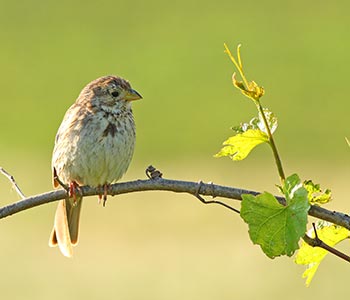
Why we call for bird counting every year
Two organisations call for bird counts in winter. Birdlife carries out Austria's largest bird count in January, focussing on winter bird species in urban and rural areas. This is followed in February by the Big Farmland Bird Count, a count of songbirds and farmland birds in open fields. Organised by Gut Hardegg in cooperation with the British Game And Wildlife Conservation Trust and Game Conservancy Germany. Both counts are used for scientific research into bird populations with the aim of counteracting their progressive decimation.
Bird count:
Online-Tool available at guthardegg.at/vogelzaehlung
February 2024
The Big Farmland Bird Count is taking place this year from 2 to 18 February. Farmer Maximilian Hardegg from the Hardegg Estate in Lower Austria's Weinviertel region has been cooperating with the two scientific institutes for this count for many years. The reason for this is the alarming threat to our songbirds and farmland birds. Monocultures, cleared landscapes and land consolidation have upset the balance of our natural world and are leading to a sharp decline in bird populations among other things. According to the Game Conservancy Germany, populations in open fields have fallen by around 50 per cent since 1980. That of the corn bunting, bird of the year 2024 in Austria and pictured here, has even fallen by 95 per cent in the last 25 years. More information on the corn bunting below.
The annual bird count is intended to
- draw the general attention of land managers and nature lovers to bird decline
- raise awareness of their important role in the conservation of farmland birds and measure the impact of their conservation work
- create a greater understanding of the beauty of nature and the possibilities of landscape design.
- DOWNLOAD of the counting sheet. please fill it in and send it by e-mail to Gut Hardegg (office@guthardegg.at). Or enter the data at home in the Online-Tool.
- ONLINE COUNTING: guthardegg.at/vogelzaehlung
- LOTTERY: A prize draw will be held among all participants for gourmet packages from Gut Hardegg (also applies to children).
A big THANK YOU to everyone who takes part in the bird count. By the way, birdwatching makes you happy!
The corn bunting, a rather inconspicuous grey and brown farmland bird, is acutely threatened with extinction according to Birdlife. Intensive farming, the lack of fallow land and field margins as well as the excessive use of pesticides and thus the destruction of insects and spiders - the main food of the young birds - are the reasons for this. The corn bunting is a symbol of many bird species whose existence is endangered.
Occurrence. The corn bunting breeds in small distribution islands in the eastern Weinviertel (Lower Austria), in the Marchfeld (Lower Austria), on the Parndorfer Platte (Burgenland) and in the Lake Neusiedl area (Burgenland). The most important breeding area in Austria is the Hanság (Burgenland) with 50 mapped territories in 2022. Outside of these areas, the corn bunting has disappeared throughout Austria apart from a few small relict occurrences. It feels most at home in warm, open environments and prefers landscapes with low shrubs, dense, low vegetation and open farmland.
Diet. The Bird of the Year 2024 feeds mainly on cereal grains, plant parts and seeds and plant parts. However, they also feed on insects and spiders, which are used exclusively to feed the young birds. As insects and spiders are becoming increasingly scarce due to intensive farming, there is a lack of food for the young grey buntings.
The portraits of the corn bunting and all other birds can be found on the website of Nabu.




